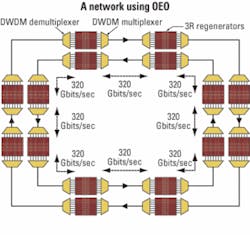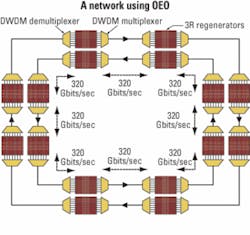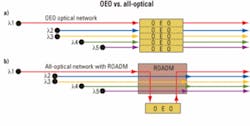All-optical tops OEO for metro and regional
by Winston I. Way
All-optical networks are also called transparent optical networks. An optical network that uses optical-electronic-optical (OEO) regenerators to retime, reshape, and reamplify (3R) at every intermediate node is called an opaque network. An all-optical network offers two major advantages over opaque networks: 1) it allows any selected wavelength to bypass electronic signal processing at intermediate regeneration sites and saves regenerator equipment cost, and 2) it is independent of data rates and signal formats. An opaque network, although rather expensive when there is a high percentage of express traffic in every network node, cleans up and improves cumulative optical transmission impairments.
There have been many discussions regarding transparent versus opaque optical networks since the late 1990s, centering on national-scale optical networks. However, the technical and economic considerations for metro and regional networks are very different from those of national-scale networks, and are therefore the focus of this article.
Architecture and equipment cost considerations
In metro and regional optical networks, express traffic (traffic that passes through a node as opposed to terminating at a particular node) occupies a significant percentage of the total traffic for the majority of the network nodes. If the express traffic is terminated and regenerated at every node, the total equipment cost due to unnecessary OEO conversion could drastically increase.
In addition to the express traffic, broadcast or multicast signals such as IPTV or high-definition TV (HDTV) should also be transported transparently to avoid multiple regenerators at every intermediate node. As the amount of video traffic in the network grows, network equipment costs could grow dramatically if the wrong architecture choice is made.
An important optical network concept that has often been overlooked is shared versus dedicated bandwidth. If an optical network must terminate transmission links by OEO regenerators in every node, the entire network can only provide “shared bandwidth.” For example, if we assume a ring network has eight nodes and 32×10-Gbit/sec wavelengths from node to node, as shown in Fig. 1, then each node can only obtain a shared bandwidth of 40 Gbits/sec (=320 Gbits/sec/8), while 512 (=32×8×2) 10-Gbit/sec transponders must be used in a dual-fiber ring network.
If a centralized all-optical architecture is used to achieve 40-Gbit/sec add/drop bandwidth per node and still have fiber and equipment protection as in Fig. 1, only 112 transponders are used (see Fig. 2). It is clear that the dramatic savings on 10-Gbit/sec transponders is due to the express bypass capability of the all-optical architecture. Note from Figs. 1 and 2 that by using the all-optical architecture there are also significant savings on routers or SONET/SDH equipment. Also, if the OEO is non-SONET/SDH, such as 10-Gigabit Ethernet switch/routers, the Layer 2/3 recovery time after a fiber break could significantly exceed 50 msec.
Figure 2. A centralized, transparent DWDM ring network using all-optical transit nodes requires fewer transponders than its OEO counterpart.
In an all-optical ring network with reconfigurable optical add/drop multiplexer (ROADM) functionality, any wavelength originated from a particular node can be directed to any other node, serving as dedicated bandwidth. Consequently, a powerful architecture results-a physical ring, logical mesh is formed for any-to-any connectivity (see Fig. 3). Note also that the dedicated bandwidth (the colored arrows in the ring network of Fig. 3) can vary from small to large bandwidth without the uniform bandwidth restrictions imposed on an OEO-based ring network. The fact that an all-optical architecture allows uneven traffic distribution-i.e., more bandwidth allocated to “heavy nodes” while less bandwidth allocated to “light nodes”-enables minimal network planning and maximum wavelength flexibility.
A simple example to show how an optical ROADM can save regenerator cost is shown in Fig. 4. In Fig. 4a, an OEO network node uses five regenerators to regenerate five wavelengths (λ1, λ 2, …, λ5), irrespective of the fact that some of the wavelengths have only traversed a very short distance and regeneration is not necessary. In Fig. 4b, an all-optical network node with a ROADM selects only λ1, which has traveled a long distance, to be dropped, regenerated, and re-added to the system. This architecture saves four regenerators.
Another important fact about OEO equipment cost pertains to fork-lift upgrades. Recall that in a conventional first-generation SONET/SDH ring, an OEO architecture is always used. A well-known problem with such a SONET/SDH ring is that, even when capacity upgrade is needed only between a pair of nodes, the capacity of every span must be upgraded at the same time. In other words, the entire SONET/SDH ring must be upgraded even when there is only one span that requires more capacity, thus the term “fork-lift upgrade.” The cost of capacity upgrade was a major driver behind transparent DWDM deployment. Therefore, it is essential to realize that, if we go back to the OEO architecture, whenever there are any traffic additions to the original network that exceed the maximum point-to-point capacity between any two nodes, we will repeat the same painful fork-lifting history.
Note also that many OEO regenerators cannot handle multiple protocols-e.g., Gigabit Ethernet, 10-Gigabit Ethernet, SONET/SDH, Fibre Channel, etc.-and cause further upgrade issues for converged services. Conversely, an all-optical network infrastructure is transparent to any network protocol, and various transponders attached to the basic infrastructure can be used for various protocols.As a result, alien wavelength injection from a third-party equipment vendor is much easier to carry out in an all-optical network.
True transparency is not always achievable
As mentioned above, a truly transparent optical network not only allows express traffic to bypass multiple OEO transponders, but should also be bit-rate (e.g., 2.5, 10, 40, 100 Gbits/sec) and signal-format (e.g., NRZ, RZ, etc.) independent. However, many transmission impairments are bit-rate and signal-format dependent, which makes the realization of an all-optical network more difficult.
In a typical metro/regional ring network with a ring circumference smaller than ~1,000 km, impairments due to optical nonlinearities and optical amplifier noise can usually be controlled and still result in a conservative system margin. However, dispersion compensation at 10 or 40 Gbits/sec and automatic polarization-mode dispersion (PMD) compensation at 40 Gbits/sec are tougher problems to solve. These problems will become even more difficult when a serial 100-Gigabit Ethernet signal is to be transported in the future.
A good transmission solution is to upgrade an existing 10-Gbit/sec infrastructure to 40 Gbits/sec (or an existing 2.5-Gbit/sec infrastructure to 10 Gbits/sec) without modifying optical power and chromatic dispersion budgets (i.e., no outside plant change). For both cases, using an ultradense WDM technique with a high spectral efficiency (while running at the same data rate as the old infrastructure) is the most economically and technically feasible approach. Other techniques such as electronic dispersion compensation (EDC) or tunable optical dispersion compensation can also be used, but usually with a very limited dispersion tolerance (<3,000 psec/nm).
True transparency is also affected by the pass-bandwidth reduction due to cascaded DWDM multiplexers, demultiplexers, filters, and ROADMs. This kind of bandwidth reduction depends more on the number of add/drop nodes than distance.
The problem with pluggables
Although pluggable optical transceiver modules such as SFPs, XFPs, XENPAKs, GBICs, etc., have become prevalent, they generally have very limited functionality due to the limited package space. Specifically, all pluggable optics currently have the following limitations:
- No forward error correction (FEC) capability, thus not G.709 compatible and cannot be used for longer distances (e.g., greater than 600 km).
- No tunable laser or tunable filter built into the package, i.e., no wavelength agility.
- Wavelength stability is poor and therefore cannot be used at spacings of 50 GHz or narrower.
- Limited launched power and poor receiver sensitivity.
In general, pluggable optical transceivers serve as a demarcation point between LANs and MANs or between LANs and WANs.
We’ve reviewed network architecture considerations by comparing all-optical and OEO architectures, leading to the conclusions summarized below:
• An all-optical architecture is significantly more economical than an OEO-based optical network architecture in metro/regional networks, because in metro/regional networks express traffic occupies a significant percentage of the traffic at a network node.
• Most metro and regional networks use ring architectures for fiber and equipment protection purposes. OEO at every node is particularly unsuitable for a ring network because of the same fork-lift upgrade issues encountered in first-generation SONET/SDH. In addition, long latency induced by OEO and the potentially slow fiber recovery for non-SONET/SDH OEO equipment can be detrimental to highly demanding video services.
• In an optical network with a ring circumference smaller than ~1,000 km, typical optical transmission-induced degradations due to optical amplifier noise/gain tilt and optical fiber nonlinearity can all be well controlled and managed, especially with the help of the newly adapted ITU-T G.709 forward error correction. Chromatic-dispersion-induced intersymbol interference can also be minimized by many newly developed dispersion-tolerant techniques such as ultradense WDM, EDC, and tunable optical dispersion compensators.
In summary, considering the economic and technical implications of network operations, the all-optical network architecture is much more suitable for metro and regional optical networks than the OEO architecture. However, an all-optical transmission system needs to be carefully designed such that it can be easily upgraded to higher capacity with the best chromatic dispersion tolerance, bandwidth transparency, optical signal-to-noise ratio resilience, and flexible add/drop wavelength granularity.Winston I. Way is chief technology officer and founder of OpVista Inc. He can be reached at [email protected].




